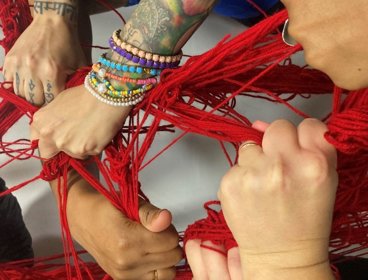By Lorraine van Blerk, University of Dundee, Janine Hunter, University of Dundee, and Wayne Shand, University of Manchester/EDP Associates
The sometimes-harsh realities of life for children and youth growing up in cities only received significant attention in geographical research. It has come to acknowledge that daily life is organised through adult structures, oppressing some children and youth who lack fora for exercising agency. Further, the complexity of society means that experience varies with characteristics such as gender, race, class and, in the case of street children and youth, homelessness. Street young people challenge normative understandings of social life, are often considered out of place on the streets, but have much to teach geographers about the use of space and the blurring of public–private environments in cities, and therefore the way in which societies are, or should be, organised.
Growing up on the streets (GUOTS)
GUOTS is a researcher–practitioner collaboration that undertook co-produced longitudinal research with street youth in three African cities: Accra, Ghana; Bukavu, DRC and Harare, Zimbabwe. The research sought to understand the lived experiences for young people who grow up on the streets and their ability to build adult lives they value. GUOTS aimed to challenge current discourse around street young people as vulnerable (when children), or as deviant (through adolescence) and consequent policy to remove them from public space. Instead, GUOTS focused on young people’s capabilities as applied within vulnerable situations rather than on vulnerabilities themselves. Pilot research highlighted key capabilities to explore the different aspects of street youth’s daily life.
Across the cities research was co-produced with street youth and trusted organisations. Street youth researchers undertook ethnographic research with their peers over a three-year period. Each week they verbally reported their findings to a street worker who also provided regular support to the peer groups in their respective cities. Engaging third sector organisations and collaborating with frontline workers can embed research into practice. It also ensures research relevance for local and national contexts and policies, spotlighting issues important to young people. A triad of engagement between third sector organisations, youth and researchers can be an effective mechanism to develop evidence for best practice.
Embedding street work organisations in research: key lessons
Real-time change to practice
Engaging street workers in research allowed learning to be translated into action in real-time. In the quotation below, an Accra streetworker illustrates how GUOTS taught him to listen and ask the right questions and to learn new things that improved the effectiveness of support. For example, hairdressing training was considered effective, but after completing the programme many girls quickly stopped hairdressing. Through the ethnographic reports, the street worker learned that the girls had nowhere to keep their tools, which were often stolen before they were able to become established. A simple solution was to provide overnight storage enabling girls to continue hairdressing.
“It would be a great tragedy to assume that when it comes to the issue of street children, we know it all. My involvement in the Growing up on the Streets research has taught me that, we do not really know, or understand street children and youth” (Edward, Catholic Action for Street Children)
Creating a meaningful legacy
Social justice research often has an aspect of action or activism embedded within its purpose and goals. However, the long-term legacy can be limited by short-term research funding. Working with street organisations helped to fulfil GUOTS legacy by developing the capabilities needed by street youth for adult life. Third sector partners supported this through skills training, entrepreneurship support and by employing street youth researchers directly in their organisations.
“Street Empowerment Trust was created and employed Pesanai Chando and Goodwill Chipuriro as street workers, The Growing up on the Streets findings and approach influenced our approach to street work then as now.” (SET, 6 July 2020)
Researcher–practitioner collaborative research can create policy change
Often research generates relevant evidence but fails to engage with the policy changemakers in any meaningful way. Yet, organisations can have long-established relationships with government and donors, but lack concrete evidence to lobby for change. In Bukavu, evidence generated through GUOTS indicated that street youth had negative experiences accessing healthcare and that their homeless status further compounded this. Utilising the ethnographic research evidence, the organisation was able to lobby regional government to implement a process for street youth to access healthcare.
“Regarding the promise made by the Minister of Health… to grant children in street situations certificates of indigence, PEDER has initiated contacts with the provincial Division of Social Affairs of South-Kivu to provide information on the care of street children in the health sector.” (PEDER, 21 January 2021)
Summary
-
Working with organisations can enable research to be embedded into practice in real-time as findings emerge.
-
Collaborating with organisations can support legacy action on a longer-term basis, beyond the life of research.
-
Embedding organisations in research can translate evidence into policy change through close working relations with government.
Banner photo: A street youth researcher and street workers from a third sector organisation walk through an informal settlement in Accra, Ghana, by Wayne Shand.
How to cite
Blerk, L., Hunter, J., and Shand, W. (2023) Working with street youth organisations. Working with voluntary and community groups. Royal Geographical Society (with IBG) Guide. Available at: https://doi.org/10.55203/FSXT6376
About this guide
Working with voluntary and community organisations for some is a very important way to do geography. These organisation come in various shapes and sizes and may also often be referred to as the third sector, the voluntary sector, not-for-profit organisations, community groups or the civic sector. In this guide, we share the experiences of researchers doing geography in collaboration with community and voluntary organisations. A range of topics and issues are explored from health, disability and care, through to austerity, violence, and craft, amongst others. We learn about the approaches taken by geographers in their work with community and voluntary organisations, and some of the challenges they have negotiated in the process.




